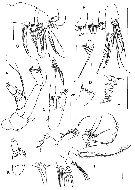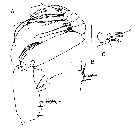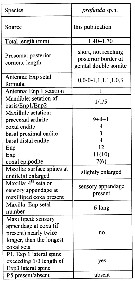|
|
 |
Fiche d'espèce de Copépode |
|
|
Calanoida ( Ordre ) |
|
|
|
Clausocalanoidea ( Superfamille ) |
|
|
|
Aetideidae ( Famille ) |
|
|
|
Paracomantenna ( Genre ) |
|
|
| |
Paracomantenna profunda Markhaseva & Renz, 2019 (F) | |
| | | | | | | Ref.: | | | Markhaseva & Renz, 2019 (p.214, Descr. F, figs.F, Rem.) |  Issued from : E.L. Markhaseva & J. Renz in Arthropoda Selecta, 2019, 28 (2). [p.216, Fig.1]. Female (from Kurile-Kamchatka Trench): A-B, habitus (dorsal and lateral); C, cephalosome (lateral); D, posterior prosome and urosome (dorsal); E, posterior prosome and genital double-somite (lateral); F, genital field (ventral); G, A1 (dotted line marks additions after another holotype limb; star marks aesthetasc). Scale bars: 0.5 mm (A-B); 0.1 mm (C-G). Nota: - Prosome 3.3-4.2 times as long as urosome. - Rostrum absent. - Cephalosome and pediger 1 incompletely separate, 4th and 5th pedigers completely separate. Posterior corners of prosome in dorsal view triangular; in lateral view pointed, directed dorsally. - Urosome 4-segmented. - Spermathecae upturned anteriorly, shape variying. - Corners' shape of posterior prosome and genital double-somite slightly variying according to the specimen's localisation (from Kurile-Kamchatka, Brazil, Angola and N Atlantic. - A1 24-segmented, reaching 3rd pedigerous somite, or exceeding to somites 4-5.
|
 Issued from : E.L. Markhaseva & J. Renz in Arthropoda Selecta, 2019, 28 (2). [p.217, Fig.2]. Female: A, A2; B, A2 expopd (different pposition); C, md palp; D-E, cutting edge of the Md gnathobase ; F, Mx1 (arrow marks praecoxal arthrite, only posterior and anterior setae figured; G, Mx2 (dotted line marks additions after another holotype limb, arrows mark basal endite setae and setae of enditic-like lobe of endopod; H, Mx2 endites and endopod; I, Mx2 endopod.
Scale bars 0.1 mm. Nota: - A2: coxa with 1 seta, basis with 2 setae; exopod 8-segmented (setal formula: 0, 0-0-1, 1, 1, 1, 1, 0, 3; all terminal setae long, of nearly the same length; 1st endopodal segment with 1 seta, 2nd segment with 8 + 7 setae. - Md: gnathobase with 4 large and 3 small teeth near dorsal seta; basis with 1 seta; exopod 5-segmented with 1, 1, 1, 1, 2 setae; endopodal segment 1 with 1 seta, segment 2 with 5 setae. - Mx1: praecoxal arthrite with 9 terminal, 4 posterior and 1 anterior setae; coxal endite with 4 setae; coxal epipodite with 6-7 setae; proximal basal endite with 3 setae, distal basl endite with 4 setae; endiopod with 12 setae; exopod with 10-11 setae (specimens show slight variability in the setation). - Mx2: praecoxal endite with 3 setae; coxal endites with 3 setae; basal endites with 3 setae each, all endites decorated with denticles that are most developed at coxal and proximal basl endites; enditic-like lobe of proximal endiopodal segment with 3 setae, one seta thicker, spine-like; endopod with 6 (1+2+3) setae.
|
 Issued from : E.L. Markhaseva & J. Renz in Arthropoda Selecta, 2019, 28 (2). [p.218, Fig.3, A-C]. Female; A, Mxp (dotted line marks additions after another holotype limb); B, Mxp, coxal and sensory appendage; C, Mxp endopod segments 1 and 2. Scale bars: 0.1 mm. A-B: specimen from the Kurule-Kamchatka; C: specimen from Northern Atlantic Nota: - Mxp syncoxa with 1 seta on proximal praecoxal endite, 2 setae on middle praecoxal endite and 3 setae on distal praecoxal endite; coxal lobe with 3 setae and sensory appendage; basis with 3 setae; endopod 6-segmented with 2, 14, 4, 3, 3+1, 4 setae, 1st segment very small.
|
 Issued from : E.L. Markhaseva & J. Renz in Arthropoda Selecta, 2019, 28 (2). [p.218, Fig.3, D-G]. Female: D, P1 (dotted line marks additions after another holotype limb); E, P2; F, P3; G, P4 ( left , dotted line marks additions after right paratype P4). Scale bars: 0.1 mm. Nota: - P5 absent.
|
 Issued from : E.L. Markhaseva & J. Renz in Arthropoda Selecta, 2019, 28 (2). [p.215, Table 1]. Selected morphological characters of P. profunda female. Compare with others Paracomantenna species female.
| | | | | NZ: | 4 | | |
|
Carte de distribution de Paracomantenna profunda par zones géographiques
|
| | | | | | | Loc: | | | Kurile-Kamchatka Trench, Angola Basin, Brazil Basin, Off S Cape Verde (10°42.89'N, 25°03.21'W), Weddel Sea (65°19.20'S, 48°03.81'W);
Type locality: 46°14.77' N, 155°32.79' E. | | | | N: | 1 | | | | Lg.: | | | (1249) F: 1,40-1,70; {F: 1,40-1,70} | | | | Rem.: | Abyssal, above sea bed. More or less 5000 m depth.
For Markhaseva & Renz (2019, p.220) , specimens of the new species show slight variability in the setatiopon of Mx1, P1 endopod ornamentation, in the segmentation of A2 exopod and Mxp endopod., also according to the localisation. | | | Dernière mise à jour : 19/06/2023 | |
|
|
 Toute utilisation de ce site pour une publication sera mentionnée avec la référence suivante : Toute utilisation de ce site pour une publication sera mentionnée avec la référence suivante :
Razouls C., Desreumaux N., Kouwenberg J. et de Bovée F., 2005-2025. - Biodiversité des Copépodes planctoniques marins (morphologie, répartition géographique et données biologiques). Sorbonne Université, CNRS. Disponible sur http://copepodes.obs-banyuls.fr [Accédé le 17 décembre 2025] © copyright 2005-2025 Sorbonne Université, CNRS
|
|
 |
 |








